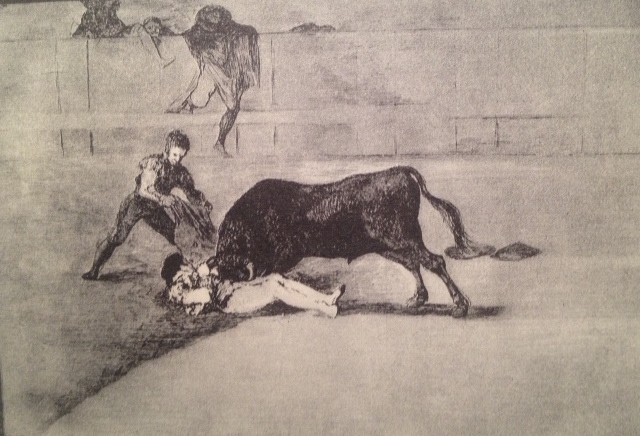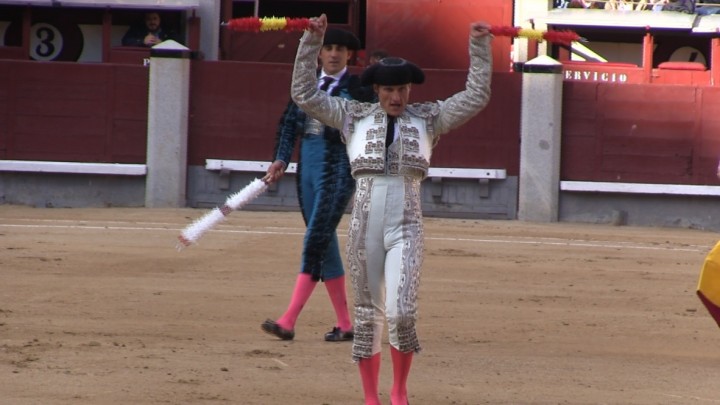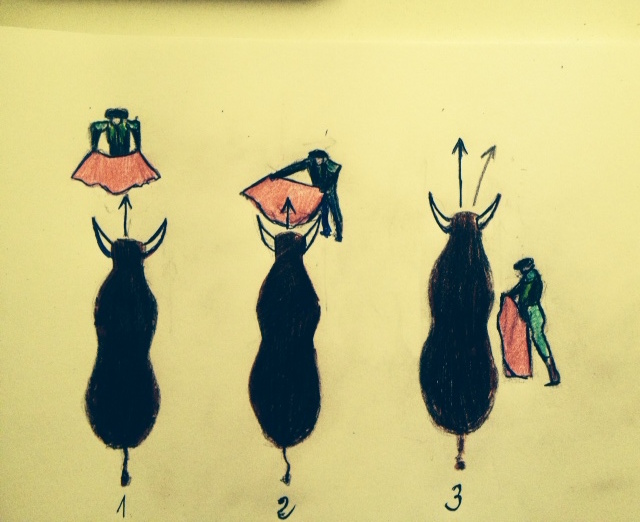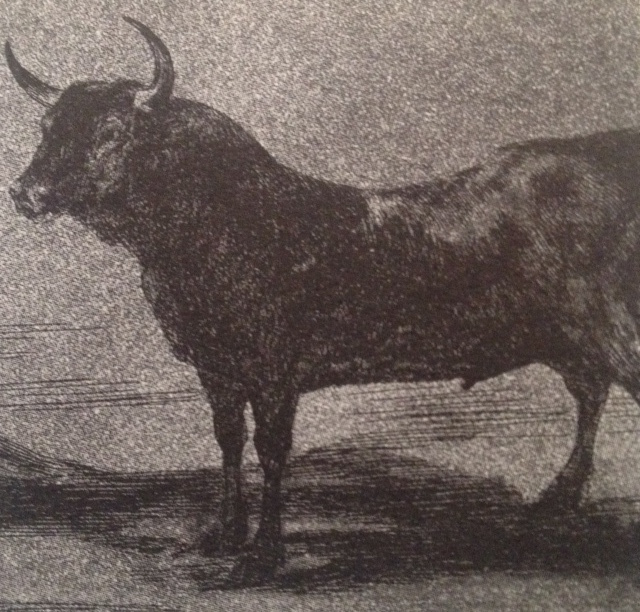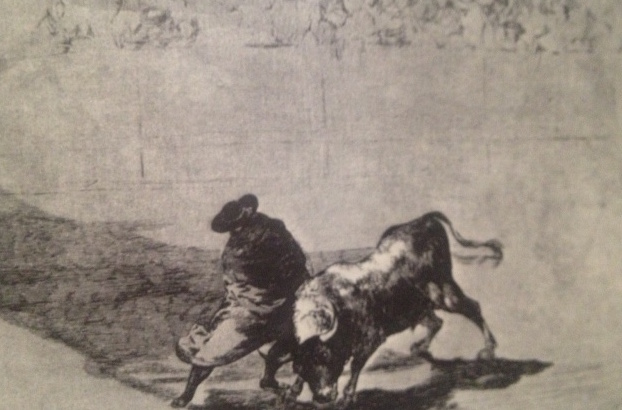 FRANCISCO DE GOYA was 70 years old when he made “TAUROMAQUIA”, a series of 33 engravings about bullfighting scenes. He used techniques of etching and aquatint. Since he was Young he liked bullfights very much. Some of these prints were made to ilustrate the text by Moratín “Historical Letter about the origins and progress of bullfights in Spain, publised in 1777.
FRANCISCO DE GOYA was 70 years old when he made “TAUROMAQUIA”, a series of 33 engravings about bullfighting scenes. He used techniques of etching and aquatint. Since he was Young he liked bullfights very much. Some of these prints were made to ilustrate the text by Moratín “Historical Letter about the origins and progress of bullfights in Spain, publised in 1777.
The title of one of these prints is “El diestrísimo estudiante de Falces, embozado burla al toro con sus quiebros” and represents the peculiar way of fighting of Falces, a legendary student or graduate born in 1709. He used to fight the bull inside a circle painted by himself previously.
The Museum of the Academy of Fine Arts of San Fernando houses the most important collection of engravings by Francisco De Goya. To this collection belongs “Tauromaquia” a series of engravings about the bullfighting world in general and bullfights in particular, which undoubtedly contributes to a deeper understanding of the meaning of this ancient tradition. The Museum of the Academy of Fine Arts of San Fernando is located in Calle Alcalá 13, Madrid. The opening hours are from Tuesday to Sunday from 10 to 15 hours.
Ernst Hemingway describing bullfight first hand: A Technical Error
Ernst 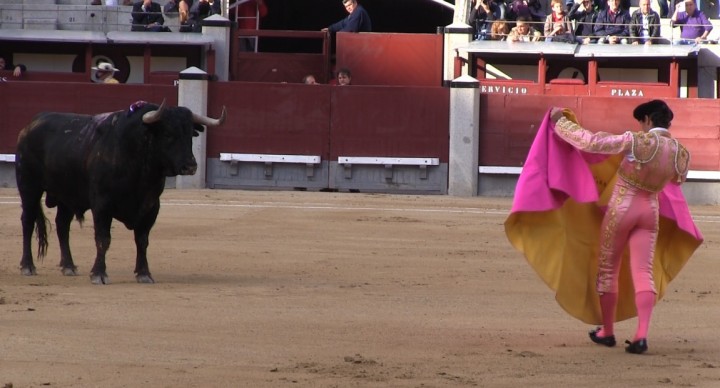 Hemingway described in “Death In The Afternoon” how a bullfighter was gored due to a technical error when he was attending a Novillada in Madrid
Hemingway described in “Death In The Afternoon” how a bullfighter was gored due to a technical error when he was attending a Novillada in Madrid
“One time in Madrid I remember we went to a novillada in the middle of the summer on a very hot Sunday when every one who could afford it had left the city for the beaches of the north or the mountains and the bullfight was not advertised to start until six o’clock in the evening, to see six Tovar bulls killed by three aspirant matadors who have all since failed in their profession. We sat in the first row benind the wooden barrier and when the first bull came out it was clear that Domingo Hernandorena, a short, thick-ankled, graceless Basque with a pale face who looked nervous and incompletely fed in a cheap rented suit, if he was to kill this bull would either make a fool of himself or be gored. Hernandorena could not control the nervousness of his feet. He wanted to stand quietly and play the bull with the cape with a slow movement of his arms, but when he tried to stand still as the bull charged his feet jumped away in short , nervous jerks. His feet were obiously not under his personal control and his effort to be statuesque while his feet jittered him away ou of danger was very funny to the crowd. It was funny to them because many of them knew that was how their own feet would behave if they saw the horns coming toward them, and as always , they resented any one else being in there in the ring, making money, who had the same physical defects which barred them, the spectators, from that supposedly highly paid way of making a living. In Hernandorena’s nervous jerking was even worse after their performance. He had not been in the ring with a bull for over a year and he was altogether unable to control his nervousness. When the banderillas were in and it was time to go out with the red cloth and ths sword to prepare the bull for killing and to kill, the crowd which had applauded ironically at every nervous move he had made knew someting very funny would happen. Below us, as he took the muleta and the sword and rinsed his mouth out with wáter I could see the muscles of his cheeks twitching. The bull stood against the barrier watching him. Hernandorena could not trust his legs to carry him slowly toward the bull. He knew there was only one way he could stay in one place in the ring. He ran out toward the bull, and ten yards in front of him dropped to both knees on the sand. In that position he was safe from ridicule. He spread the red cloth with his sword and jerked himself forward on his knees toward the bull. The bull was watching the man and the triangle of red cloth, his ears pointed, his eyes fixed, and Hernandorena kneeéd himself a yard closer and shook the cloth. The bull’s tail rose, his head lowered and he charged and, as he reached the man, Hernandorena rose solidly from his knees into the air, swung over like a bundle, his legs in all directions now, and the dropped to the ground. The bull looked for him found a wide´spread moving cape held by another bullfighter instead, charged it, and Hernandorna stood up with sand on his White face and looked for his sword and the cloth. As he stood up I saw the heavy, soiled gray silk of his rented trousers open cleanly and deeply to show the thigh bone from the hip almost to the knee. He saw it too and looked very surprised and put his hand on it while people jumped over the barrier and ran toward him to carry him to the infirmary. The technical error that he had committed was in not keeping the red cloth of the muleta between himself and the bull until the charge; then at the momento of jurisdiction as it is called, when the bull’s lowered head reaches the cloth, swaying back while he held the cloth, spread by the stick and the sword, far enough forward so that the bull following it would be clear of his body. It was a simple technical error.”
Ernst Hemingway; Death In The Afternoon
Ernst Hemingway and Novilladas
Ernst Hemingway considered Novilladas a good starting point to understand bullfighting.
“The bulls only goes for the percale of the cape or for the scarlet of the muleta if the man makes him and so handles the cloth that the bull sees it rather than the man. Therefore to really start to see bullfights a spectator should go to the NOVILLADAS or apprentice fights . There the bulls do not always go for the cloth because the bullfighters are learning before your eyes the rules of bullfighting and they do not always remember or know the proper terrain to take and how to keep the bull afgter the lure and away from the man. It is one thing to now the rules in principle and another ot remember them as they are needed when facing an animal that is seeking to kill you and the spectator who wants to see men tosed and gored rather than judge the manner in which the bulls are dominated should go to go a Novillada before he sees a Corrida de Toros. I should be a good thing for him to see first a Novillada anyway if he wants to learn the technique, since the employment of knowledge that we call by that bastard name is always most vivible in its imperfection. At a Novillada the spectator may see the mistakes of the bullfighter and the penalties that these mistakes carry. He will learn something too about the state of training or lack of training of the men and the effect this has on their courage.”
Ernst Hemingway and the bullfights
Ernst Hemingway traveled to Spain becausse que wanted to attend bullfights and study them in detail in order to get a first hand knowledge that allowed him to write truthfully about death or, as he says, about the feeling of life and death.
In the first chapter of his famous book “Death in the afternoon”, he explains what should be the psychological attitude of those who are going to attend a bullfight for the first time
1- Fidelity to what you see and feel
When we judge a fact we must distinguish what we feel and what we think we should feel. The bullfight is not an exception. Hemingway wanted to talk about bullfights without prejudice or preconceived ideas, and from the absolute fidelity to what he feels during the show.
2- A general and total visión of the show
A correct judgment of bullfighting must be based on a complete and total vision of the show. Separating a part of the whole or decontextualizing it, inevitably leads to a biased view.
3. Knowing in depth
The appreciation and pleasure that an artistic event can provide increase with a deeper knowledge of it. The greater the knowledge of bullfights is, the greater our ability to appreciate them will be. First one perceives the anecdotal and then, little by little, gets to the essential.
4- Patience
Probably the first bullfight we attend will be not artistically good. An artistically good bullfight requires good bulls and good bullfighters. Good bullfighters with bad bulls do not give an interesting show. Who goes to the bullfight for the first time can not expect to find a combination of an ideal bullfighter with an ideal bull. He must be patient.
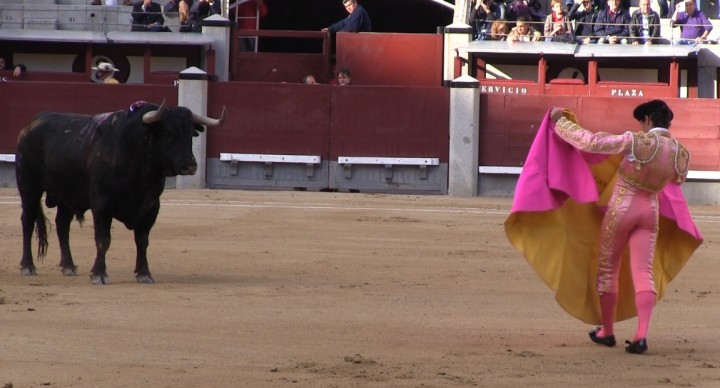
Bullfighting and Poetry:Federico García Lorca. “At Five In The Afternoon”
Federico García Lorca, 1898-1936 , the most popular poet of the 20th century Spanish literatura, wrote in 1935 4 elegies under the name of “Llanto por la Muerte de Ignacio Sanchez Mejías, dedícated to his friend, the bullfighter Ignacio Sánchez Mejías, dead from gangrene as a consequence of a goring at the Bullfighting Ring of Manzanares. This is the first one, La Cogida y La Muerte..
At five in the afternoon.
It was exactly five in the afternoon.
A boy brought the white sheet
at five in the afternoon.
A frail of lime ready prepared
at five in the afternoon.
The rest was death, and death alone.
The wind carried away the cottonwool
at five in the afternoon.
And the oxide scattered crystal and nickel
at five in the afternoon.
Now the dove and the leopard wrestle
at five in the afternoon.
And a thigh with a desolated horn
at five in the afternoon.
The bass-string struck up
at five in the afternoon.
Arsenic bells and smoke
at five in the afternoon.
Groups of silence in the corners
at five in the afternoon.
And the bull alone with a high heart!
At five in the afternoon.
When the sweat of snow was coming
at five in the afternoon,
when the bull ring was covered with iodine
at five in the afternoon.
Death laid eggs in the wound
at five in the afternoon.
At five in the afternoon.
At five o’clock in the afternoon.
A coffin on wheels is his bed
at five in the afternoon.
Bones and flutes resound in his ears
at five in the afternoon.
Now the bull was bellowing through his forehead
at five in the afternoon.
The room was iridiscent with agony
at five in the afternoon.
In the distance the gangrene now comes
at five in the afternoon.
Horn of the lily through green groins
at five in the afternoon.
The wounds were burning like suns
at five in the afternoon.
At five in the afternoon.
Ah, that fatal five in the afternoon!
It was five by all the clocks!
It was five in the shade of the afternoon!
Bacon and Bullfight
In the second half of the 20th century Francis Bacon (1909-1992) traveled to France and Spain, where for the first time he attended a bullfight. His experience with bullfights and his admiration for Picasso and Lorca moved him to represent his personal view of the world of bullfighting. In 1969 he painted Three Studies For A Bullfight and in 1991, one year before his death , he painted Study Of A Bull, in which a bull seems to emerge from a black rectangle. 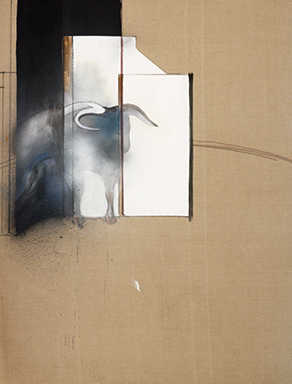
La Verónica
MANOLETE
Manolete, ( Manuel Laureano Rodriguez Sanches) considered to be one of the best bullfighters of all time, was born in Cordoba on 4th July 1917 and killed by the Miura bull “Islero” at the Linares Bullfighting Ring in August 1947. In 1930 was his public debut in the Montilla School of Bullfighting in Cordoba. In 1940 he was at all the most important bullfights in Seville, Bilbao, Barcelona and Madrid and became the star of Spanish bullfighting. In June 1939 he fought for the first time as a “Novillero” and one month later becomes a Matador, receiving his “alternativa” in Chiclanero, Seville. He confirmed his “alternativa” in Madrid on 12th October of the same year at by Marcial Lalanda. At the end of the 1945 season he travelled to South America where his successes in the bullrings of Mexico. Peru, Venezuela and Colombia made him the most famous bullfighter in the world. His style was sober and serious, with few concessions to the gallery . He used to stand very still while the bull passed close to his body. He was able to remain in one spot and link four or five consecutive passes together into a compact series. He invented a pass with the muleta called “Manoletina.
In 2008 Menno Meyjes directed The Passion Within, a movie about Manolete’s late live and love affair with the actress Lupe Sino before he was gored to death in the Bull Ring. Adrien Brody and Penelope Cruz played the roll of Manolete and Lupe Sino.
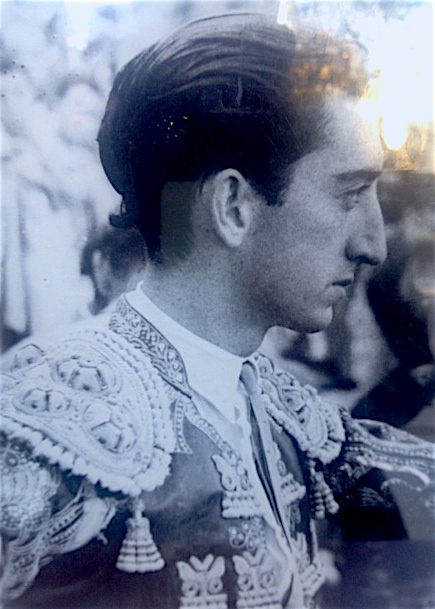
Goya And Bullfighting
The Museum of the Academy of Fine Arts of San Fernando is located in Calle Alcalá 13, Madrid. The opening hours are from Tuesday to Sunday from 10 to 15 hours. This museum houses the most important collection of engravings by Francisco De Goya. To this collection belongs “Tauromaquia” a series of engravings about the bullfighting world in general and bullfights in particular, which undoubtedly contributes to a deeper understanding of the meaning of this ancient tradition.